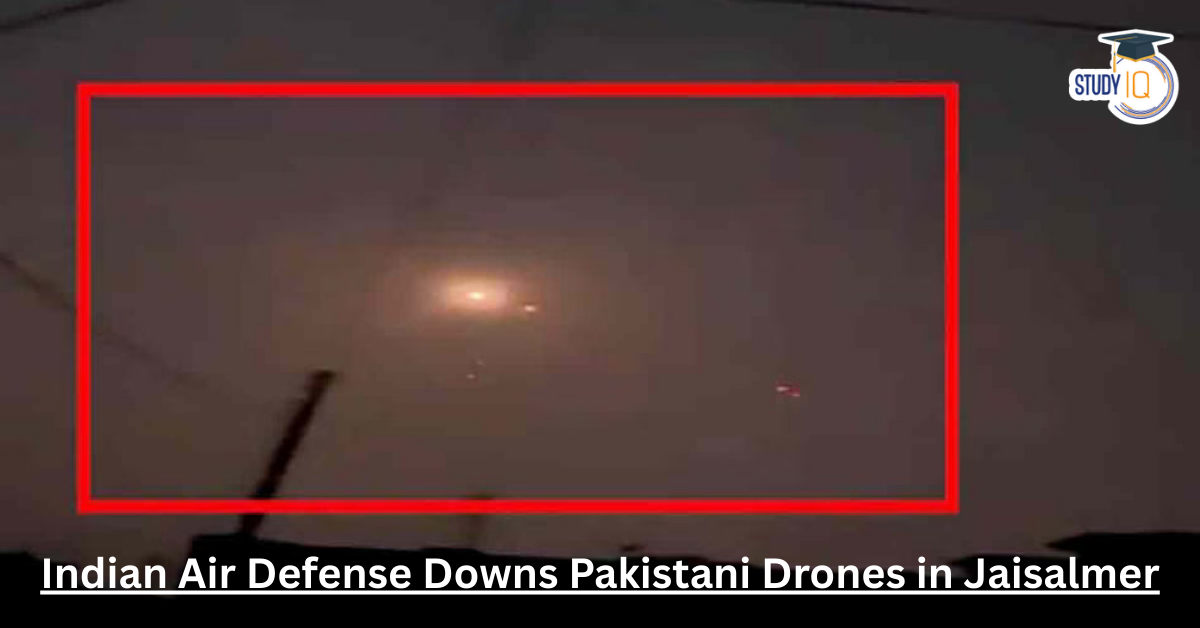The ongoing tensions between India and Pakistan have intensified dramatically in recent days, with the latest escalation involving a drone attack targeting Jaisalmer, a critical area in Rajasthan. Pakistani drones, launched late Thursday, attempted to breach Indian airspace, but all drones were successfully neutralized by India’s air defense systems before they could reach their intended targets. Despite the interception, heavy shelling continued along forward border posts, adding to the volatile situation on the ground.
Rising Tensions and Immediate Response
This drone infiltration marks a significant development in the escalating conflict, which was initially triggered by a Pakistani strike on Jammu. The attack on Jammu raised alarms within Indian defense circles, prompting the immediate activation of India’s robust multi-layered air defense network. Key to India’s defense capability is the deployment of the S-400 missile system, a high-end air defense asset capable of intercepting and neutralizing multiple threats, including missiles and drones.
On Thursday night, Indian air defense units successfully intercepted eight Pakistani missiles aimed at key targets such as the Jammu civil airport, Samba, RS Pura, and Arnia. The missiles were destroyed mid-air by the S-400, a clear demonstration of India’s advanced air defense technology and its preparedness for such threats.
Also Read: India Destroyed S-400 Missile Defence System
Increased Military Operations and Border Security
With fears of further escalation, India’s military response has become more robust and expansive. Indian Army and Border Security Force (BSF) forces have taken proactive steps, establishing a 100 km security zone along the India-Pakistan border. Intelligence reports suggest that heavy troop mobilization has been observed along the border, raising concerns about potential additional hostilities. As a precaution, the Indian government has raised security alert levels across northwestern India, particularly in Rajasthan, where the conflict has now spread, affecting the once-calm region.
To aid in the defense efforts, electrical outages have been implemented across the region, with Jammu experiencing a total blackout to hinder enemy reconnaissance and airstrike capabilities. The power outage extended as far as Amritsar, further amplifying the sense of urgency in the area.
Drone Threats and Interceptions
As the situation continues to escalate, multiple reports indicate ongoing drone attacks in areas like Udhampur, Akhnoor, Jammu, and Pathankot. In addition to the attacks targeting Jaisalmer, two Pakistani drones were shot down near Jammu University. The Indian air defense teams have remained active, successfully engaging and intercepting incoming threats in real-time. Their swift and decisive actions have played a key role in averting potential disasters, protecting both military and civilian installations.
The ceasefire violations in the region are now widespread, with artillery shelling and aerial intrusions continuing throughout Samba and other border districts. Despite these challenges, Indian defense units, including surface-to-air missile (SAM) units, remain on high alert, ready to respond to any further provocations from the Pakistani side.
Also Read: Total Blackout in Jammu and Kashmir and Drone Infiltration
Strategic Shift and Broader Implications
The conflict’s recent developments have significant implications for the stability of the region. With Pakistan’s use of drones becoming an increasing part of its military strategy, India has been forced to ramp up its air defense capabilitiesand adjust its military approach. The use of swarm drones represents a tactical shift, moving away from traditional methods of conflict to more covert and disruptive forms of warfare.
The conflict now extends beyond Jammu and Punjab, as Rajasthan becomes the latest area to experience heightened tensions. With the Indian Army and BSF now controlling a 100 km buffer zone, India is taking every precaution to prevent further incursions. The possibility of additional airstrikes or artillery bombardments remains a serious concern, especially as military intelligence reports suggest ongoing mobilization on both sides of the border.
Global Attention and Future Outlook
The escalation between India and Pakistan has captured global attention, with analysts closely watching for signs of further conflict. As both countries prepare for the possibility of a broader confrontation, the international community remains on edge, urging both sides to de-escalate and avoid any actions that could lead to a full-scale war.
India has made it clear that any further acts of aggression will be met with a strong and proportionate response, signaling that the situation remains highly unpredictable. While the immediate threat of drone attacks has been neutralized, both nations remain on high alert, as the conflict continues to unfold with no clear resolution in sight.


 India AI Governance Guidelines 2025: Ena...
India AI Governance Guidelines 2025: Ena...
 GPS Spoofing: Meaning, Working, Types, I...
GPS Spoofing: Meaning, Working, Types, I...
 The Case of Universal Basic Income (UBI)...
The Case of Universal Basic Income (UBI)...

























